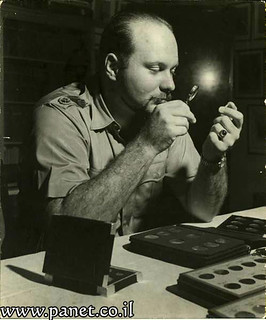
PREV ARTICLE
NEXT ARTICLE
FULL ISSUE
PREV FULL ISSUE
NOTES FROM E-SYLUM READERS: DECEMBER 30, 2012 More on the King Farouk Photo Last week you called me a showoff for identifying the photo of King Farouk. The following should put me over the top. The photo of King Farouk was taken in 1943 by John Phillips. It was included in a well-illustrated article on Farouk in Life Magazine of April 10, 1944, pages 85 to 93. The photo of Farouk examining coins was on page 92. There is another photo of Farouk looking at his collection in the Life photo archives.
Well, I'm duly impressed. Thanks for the background!
-Editor
To read the earlier E-Sylum article, see: NOTES FROM E-SYLUM READERS: DECEMBER 23, 2012: Mystery Numismatists Identified (www.coinbooks.org/esylum_v15n53a08.html) The Giori Presses The entry about the Giori press test notes, and the presses' construction for the BEP by American Can Co, includes this line: "There is no proof the presses were ever used once they made it to Washington DC." Unless Giori presses were obtained from two sources, they certainly were used, for both stamps and notes for decades. They are only now being retired in favor of the Orlof presses.
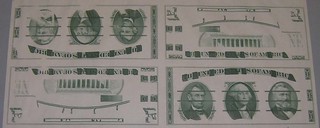
To read the earlier E-Sylum article, see: AMERICAN CAN COMPANY AND THE GIORI TEST NOTES (www.coinbooks.org/esylum_v15n53a10.html) Intaglio vs 'Offset' Banknote Printing Regarding the Peruvian counterfeiting operation, and the quote that "Printing equipment, including an offset press and materials for the production of banknotes, were also confiscated": readers should be aware that when the Secret Service refers to "offset," all they mean is "not intaglio." The operation could be direct lithography, offset lithography, letterpress, or digital (inkjet or laser) - Secret Service agents inexplicably call all of those "offset." The scale of this operation suggests direct plate lithography. For a very detailed display of this technology, see an early scene in the movie To Live and Die in L.A. To read the earlier E-Sylum article, see: POLICE IN PERU SHUT DOWN MAJOR COUNTERFEITING OPERATION (www.coinbooks.org/esylum_v15n53a22.html) Numismatic Gaffe in Lincoln Movie
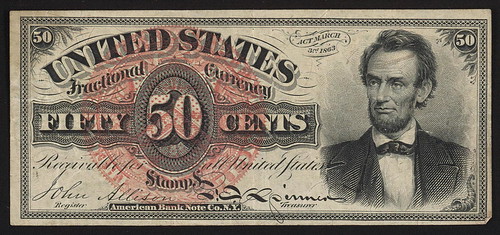
Joe Boling writes: The Lincoln 50c fractional currency note that you illustrated last week reminds me of a recent query about a line in the movie "Lincoln." (Maybe it was in a letter to the editor of one of the numismatic weeklies.) In any event, Louise and I saw the movie this week, and sure enough, there was a throw-away line to the effect of "he won't even let us use a fifty-cent piece because it has a portrait of you [Lincoln] on it." I won't try to explain the context, but the letter-writer was wondering what 50-cent piece could have been meant. I immediately thought of the fractional currency note, but on looking it up, it's still an anachronism, because that was a 4th series note not issued until the 1870s, so would also have been not available at the time of the film's story (early 1865). The screen-writers just booted it. They may have been fooled by the note itself - bearing the date of the enabling act, March 3rd, 1863.
Perhaps not so coincidentally, the reason I picked that particular image to illustrate the piece from the Huffington Post was that after publishing last week's E-Sylum my father-in-law and I were going to see the Lincoln movie. I, too, did a numismatic spit-take when that line was uttered. What were they THINKING? I had read a lot of the publicity hype about the care taken to ensure historical accuracy, and had been fairly impressed. Below are links to a couple articles I found on the topic.
Overall, I enjoyed the film, but in my opinion it's no Shindler's List - good, but not great. History and Civil War buffs should enjoy it though, and I'm sure there will be Oscars aplenty next year.
-Editor
To read the complete article, see:
Is 'Lincoln' the real deal?
(articles.latimes.com/2012/nov/28/entertainment/la-et-mn
To read the complete article, see:
How Accurate Is Lincoln?
(www.slate.com/blogs/browbeat/2012/11/09/lincoln_historical To read the earlier E-Sylum article, see: HUFFINGTON POST'S FAVORITE OLD BANKNOTES AND CURRENCY (www.coinbooks.org/esylum_v15n53a24.html) More on the Translation of "Nummis Nova" In your diary of December 16, 2012, you mentioned the Chinese calligraphy of a group named NUMMIS NOVA. I suggest the right translation according to pronunciation in Chinese should be 纽米丝 诺瓦, not 纽米氏 罗娃。I saw the translator's signature is Mr.黄,I doubt he might be from a Cantonese origin, not pure Mandarin. Here are my mandarin translations of NUMMIS NOVA, literally and phonetically. In contemporary Chinese writings (I mean with simplified Chinese), the Chinese characters should write horizontally, not vertically, from left to right, not right to left. Best regards to Tom Kays and Joe Boling.
Thanks! I was curious about the translation. Some readers may not be able to view the Chinese characters shown above in their email readers or browsers. But below is an image that should be viewable by all.
-Editor
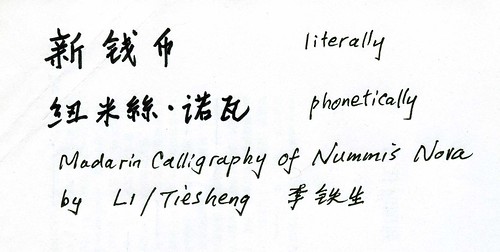
To read the earlier E-Sylum article, see: NOTES FROM E-SYLUM READERS: DECEMBER 23, 2012: Joe Boling on the Translation of "Nummis Nova" (www.coinbooks.org/esylum_v15n53a08.html) Why Eight Is a Lucky Number I am a friend of Howard Daniels'. He mentioned the lucky number "8" in Viet Nam on American banknotes. I suppose this is from Chinese origin. In Chinese "8" is nearly a homophone of "发“(fa), which is related to " 发财"(get fortune), so it become a lucky number. The car plate with number "8" ,"88", "888" or "168"(get fortune all along the road) always could win a high bid.
Thanks! Some readers may not be able to view the Chinese characters shown above in their email readers or browsers.
-Editor
To read the earlier E-Sylum article, see: LUCKY 8888 SERIAL NUMBER DOLLARS POPULAR IN VIET NAM (www.coinbooks.org/esylum_v15n53a23.html) Why Bother Studying Alternative Cent and Nickel metals? I find it astonishing that the Mint is wasting money trying to find substitute metals for the cent and nickel. In the case of the former, the cost of manufacturing the coins and delivering them to the channels of commerce will inevitably cost more than their face value, even if the material cost is zero. Both denominations have been rendered useless due to inflation and should be discontinued, the cent immediately and the nickel two or three years from now.
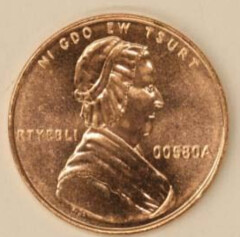

The government moves in mysterious ways...
-Editor
To read the earlier E-Sylum article, see: U.S. MINT 2012 ALTERNATIVE METALS STUDY (www.coinbooks.org/esylum_v15n53a12.html) More on the 'Flight to America' Zeppelin Medal The Zeppelin medal is of more than passing interest to Americans, as the airship depicted became the U. S. S. Los Angeles. The medal was struck to commemorate her delivery flight to America in 1924. LZ-126 (Luftschiffbau Zeppelin 126) was furnished to the U. S. Navy as part of Germany's war reparations. The Navy assigned it hull number ZR-3 (Zeppelin Rigid 3), and she operated as a training ship in anticipation of the larger fleet airships Akron and Macon. When those ships entered service in 1931-33, the Los Angeles was decommissioned and partially deflated. The loss of the Akron prompted her re-inflation, but the Los Angeles was never recommissioned and ultimately was scrapped in 1939-40, after the Navy had given up on rigid airships altogether in favor of blimps.
Interesting bit of history! Thanks.
-Editor
To read the earlier E-Sylum article, see: AN ART DECO ZEPPELIN MEDAL (www.coinbooks.org/esylum_v15n53a17.html) Correction: Smithsonian Institution The Yap stone money article says: "Smithsonian Institute," instead of INSTITUTION, the proper title.
That's a common error. I try to keep it straight in my own writing and editing, but left it alone in the quoted auction description.
-Editor
To read the earlier E-Sylum article, see:
NOTES FROM E-SYLUM READERS: DECEMBER 23, 2012: More on Yap Stone Money
(www.coinbooks.org/esylum_v15n53a08.html)
The Numismatic Bibliomania Society is a non-profit organization promoting numismatic literature. See our web site at coinbooks.org. To submit items for publication in The E-Sylum, write to the Editor at this address: whomren@gmail.com To subscribe go to: https://my.binhost.com/lists/listinfo/esylum All Rights Reserved. NBS Home Page Contact the NBS webmaster 
|
